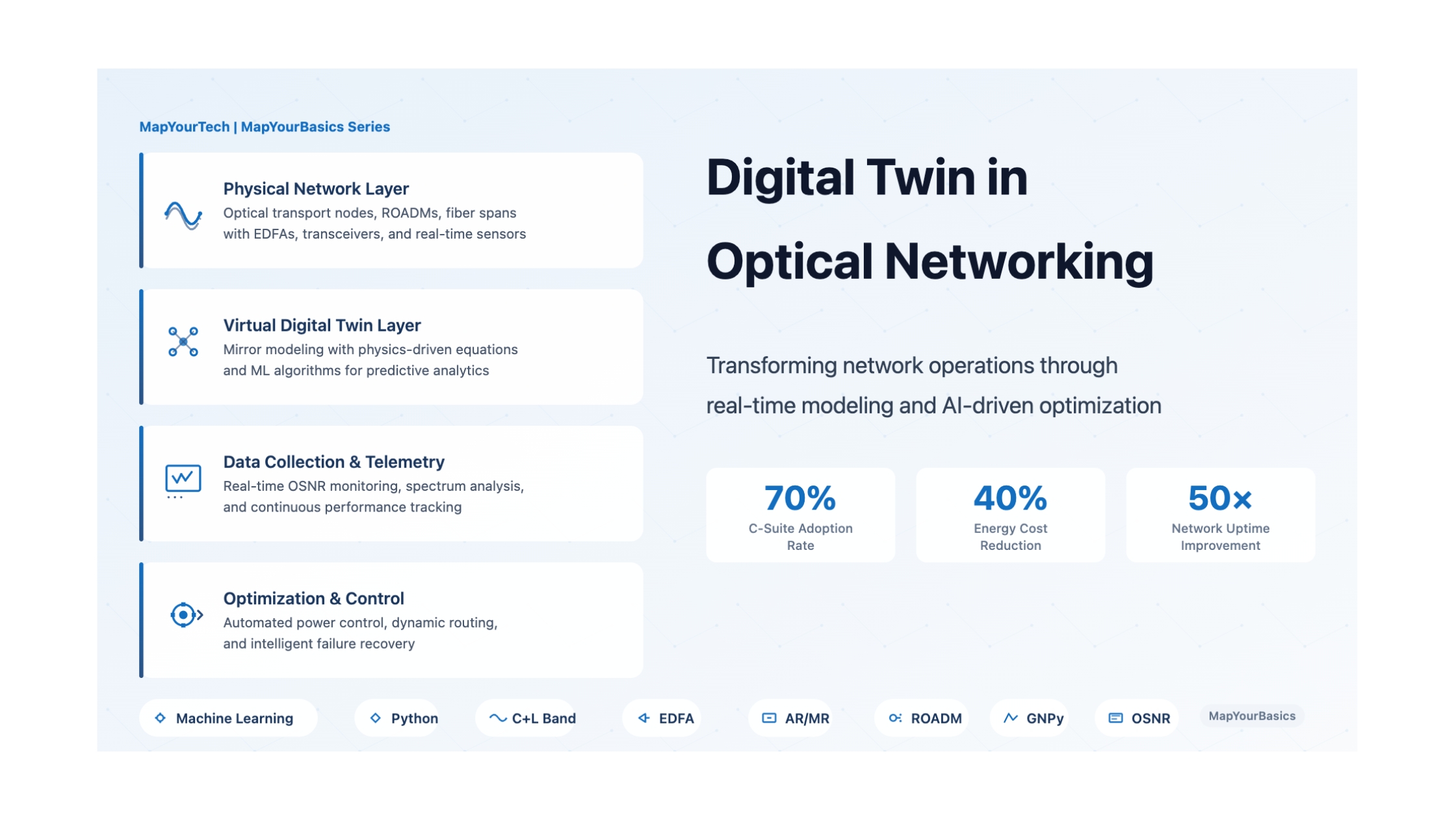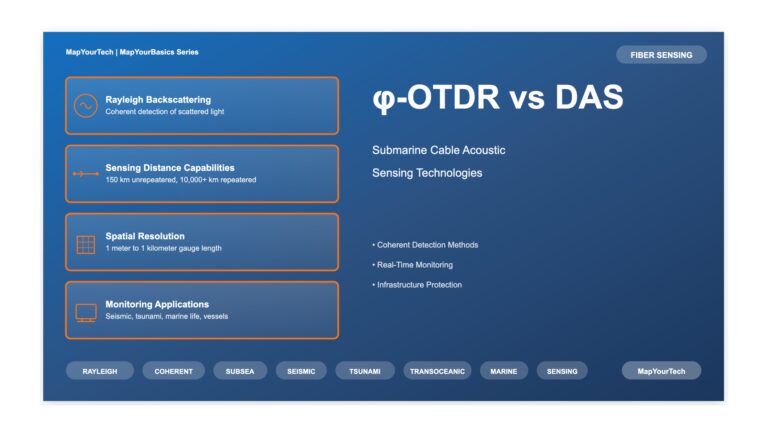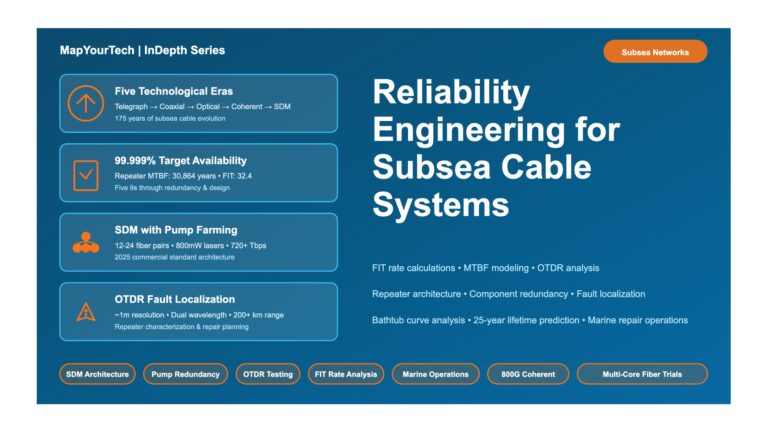Practical Aspects of Digital Twin in Optical Networking
Transforming network operations through virtual replicas, real-time monitoring, and intelligent optimization
What is a Digital Twin?
A Digital Twin is a virtual replica of a product, process, object, or network in the digital domain, created using real-time and accurate data to mimic the real-world environment. It continuously updates to reflect the original version, enabling organizations to understand operational behavior in real-life scenarios.
Market Adoption & Impact
Digital Twin vs Traditional Network Planner
- Model: Realistic, close to actual network
- Parameters: Realistic from field/lab data
- Updates: Constantly updated from real world
- Accuracy: High precision modeling
- System Margin: Low, optimized operation
- Computation: High processing power required
- Data Requirement: Simple, real-time telemetry
- Interaction: Bidirectional with physical network
- Model: Approximate, simplified equations
- Parameters: Coarse, generalized values
- Updates: No regular updates
- Accuracy: Lower precision
- System Margin: Higher than digital twin
- Computation: Low processing requirements
- Data Requirement: Complex, difficult to obtain
- Interaction: No real-world interaction
Digital Twin Architecture for Optical Networks
- Optical transport nodes and ROADMs
- Fiber spans with EDFAs
- Transceivers and wavelength channels
- Network monitoring equipment
- Real-time sensor data collection
- Fiber and amplifier models
- Transceiver and WSS simulation
- Lightpath and mesh network modeling
- Physics-driven and ML-based models
- Mirror modeling of physical network
- Performance improvement strategies
- Failure recovery and prediction
- Power control and EDFA/WSS config
- Resource allocation optimization
- Automated network optimization
Three Modeling Approaches for Digital Twins
Approach: Based on fundamental physical equations and principles
Examples:
- SRS compensation in C+L bands
- GNPy (Gaussian Noise model)
- Nonlinear propagation modeling
Best for: Well-understood physical phenomena with known parameters
Approach: Machine learning from operational data patterns
Examples:
- OSNR estimation from optical spectra
- Fault detection and classification
- EDFA gain modeling with CNNs
Best for: Complex systems with abundant training data and unknown relationships
Approach: Combines physics models with ML for parameter refinement
Examples:
- Parameter refinement in C+L networks
- GSNR estimation with corrections
- Self-learning forward modeling
Best for: Systems requiring both physical accuracy and adaptive learning
Network Optimization Strategies
Effectiveness scores based on field trials and simulations
Practical Use Cases in Optical Networks
Augmented Reality Integration for Network Management
Augmented and Mixed Reality technologies enable intuitive interaction with digital twin models, bridging virtual and physical network operations for enhanced maintenance and troubleshooting.
- Reduced operational costs through remote expertise
- Faster mean time to repair (MTTR)
- Elimination of travel time and expenses
- Enhanced training capabilities for technicians
- Remote proof of concept demonstrations
- 200 Gb/s bidirectional AR traffic over 85+ km
- Integration with transport network via OpenFlow
- Wi-Fi connected AR headset operation
- On-demand computing for ML algorithms
- Real-time synchronization of virtual and physical views
Machine Learning Applications in Digital Twins
Applications:
- Physics and ML-based QoT estimation
- Bayesian optimization for accuracy
- Field trial validation in WDM systems
- Predictive performance modeling
Techniques:
- Meta-learning for failure localization
- Soft-failure management using VAE and GAN
- Root cause analysis with ML
- Performance degradation detection
Methods:
- CNN-based EDFA gain modeling
- Self-normalizing neural networks
- One-shot transfer learning
- Wavelength-dependent gain prediction
Approaches:
- Neural network equalizers
- LSTM for O-band compensation
- Inter-subcarrier nonlinearity mitigation
- Low-complexity ML architectures
Capabilities:
- ChatGPT for alarm analysis
- AI-driven cross-domain rerouting
- Dynamic network optimization
- Telemetry-based ML deployment
Optimization:
- Power pre-emphasis optimization
- S+C+L band configuration
- ASE-NL heuristic algorithms
- Span-per-span SNR optimization
Industry Leaders and Implementation
Major telecommunications and technology companies driving Digital Twin innovation: Huawei, Ciena, Infinera, Nokia, British Telecom, Fujitsu, Telecom Italia, Corning, Orange, China Unicom, and Microsoft Azure for AI infrastructure.
COMET Project: Communications Enabled Digital Twins research proposal accepted by CELTIC, currently under funding approval by IIA for advanced network management.
Global Deployments: Field trials demonstrated across Europe, Asia, and North America for QoT estimation, failure management, and AI-driven network optimization.
Production Systems: Google's 95%+ east-west traffic through optical circuit switches, achieving 50x improvement in network uptime and significant cost reductions.
Future Trends and Emerging Technologies
Key Technical Benefits
Implementation Challenges and Solutions
- Requires accurate real-time telemetry
- Sensor calibration critical
- Data synchronization complexity
- Solution: Automated validation, ML-based anomaly detection
- High processing power needed
- Real-time simulation demands
- Storage for historical data
- Solution: Edge computing, cloud infrastructure
- Complex physical phenomena
- Parameter uncertainty
- Legacy equipment modeling
- Solution: Hybrid physics-ML models, continuous refinement
- Multi-vendor environments
- Legacy system compatibility
- Standard interfaces needed
- Solution: API standardization, vendor collaboration
Digital Twin technology represents a paradigm shift in optical network management, moving from reactive operations to predictive, autonomous systems. As networks evolve toward multi-band operation, AI integration, and hollow core fiber deployment, digital twins will be essential for managing complexity and maximizing performance.
With 70% of C-suite executives investing in digital twins and demonstrated benefits including 30%+ CapEx savings and 40% energy reduction, the technology is rapidly transitioning from research to mainstream deployment.
The convergence of digital twins, machine learning, augmented reality, and advanced optical technologies positions the industry for unprecedented innovation in network capacity, efficiency, and reliability over the next decade.
Developed by MapYourTech Team
For educational purposes in optical networking and DWDM systems
Note: This guide is based on industry standards, best practices, and real-world implementation experiences. Specific implementations may vary based on equipment vendors, network topology, and regulatory requirements. Always consult with qualified network engineers and follow vendor documentation for actual deployments.
Unlock Premium Content
Join over 400K+ optical network professionals worldwide. Access premium courses, advanced engineering tools, and exclusive industry insights.
Already have an account? Log in here




